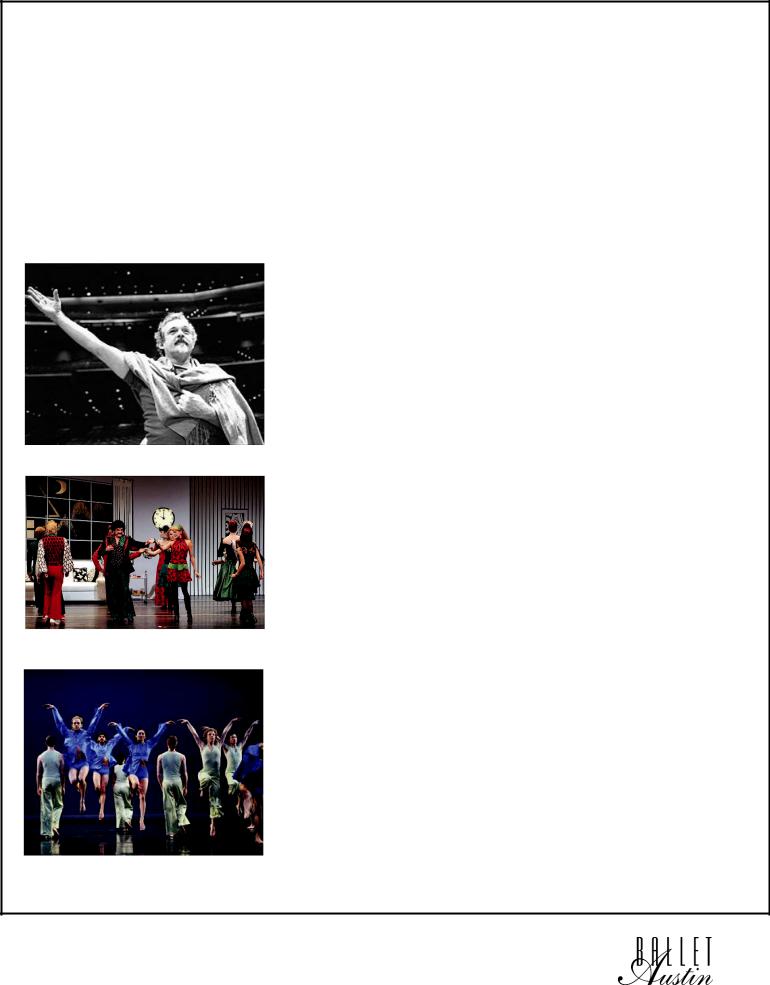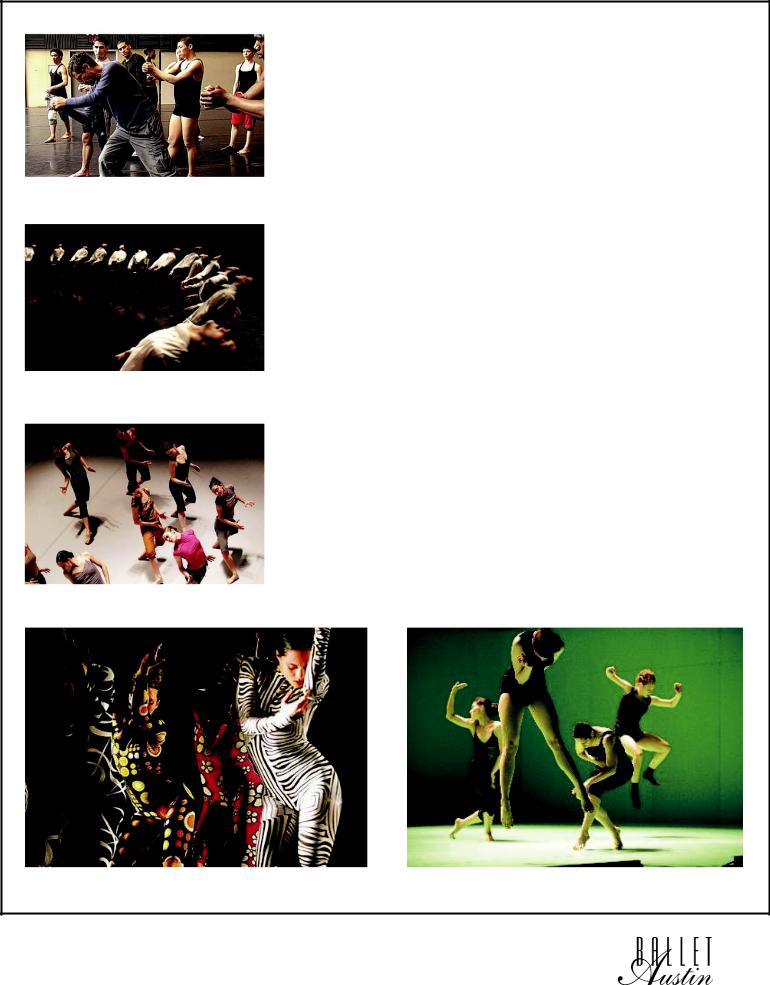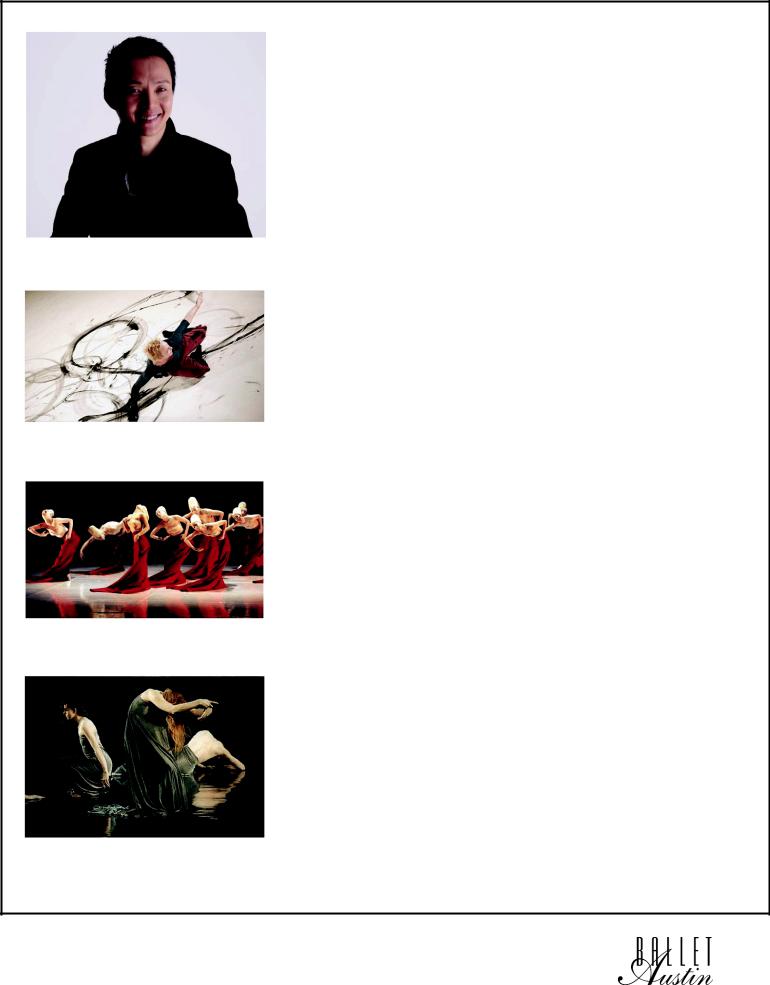
HistoryofModernDanceStudentHandout
.pdf
Modern Dance Today
The social and artistic upheavals of the late 1960s and 1970s signaled even more radical departures for modern dance. Modern dance today is much more sophisticated, both in technique and technology, than the dance begun by its pioneers. Current pioneers in modern dance find a much softer dividing line between modern dance and ballet. In truth, ballet, modern, and contemporary dance companies today have come to regard fluency in all genres of dance as important to their work.
Today’s modern dance has become a fusion of multiple dance genres, as demonstrated by choreographers Mark Morris, Ohad Naharin, and Shen Wei.
Mark Morris
Mark Morris in The Hard Nut
Mark Morris is most influenced by George Balanchine and Merce
Cunningham. He formed the Mark Morris Dance Group in 1980 and the White Oak Dance Project with Mikhail Baryshnikov in 1990. He is known as one of the greatest living modern dance choreographers, a dancer of extraordinary power, and an unpredictably imaginative theater artist.
One of his most popular works is The Hard Nut, which is Morris’ faithful interpretation of E.T.A. Hoffman’s The Nutcracker and the Mouse King. It is set in the 1960s and features sets inspired by graphic comic books and wildly colorful period costumes. The choreography is described as quirky and humorous despite the story’s dark themes.
Morris’ ballet work is included in the repertory of the San
Francisco Ballet, American Ballet Theatre, Paris Opera Ballet,
Boston Ballet, Pacific Northwest Ballet, Dutch National Ballet,
New Zealand Ballet, Houston Ballet, and The Royal Ballet.
Morris is noted for his sophisticated musicality and has been described as “undeviating in his devotion to music.” The Washington Post called Mark Morris “our Mozart of modern dance.ʺ The Los Angeles Times calls him, “intensely musical, deceptively cerebral, insinuatingly sensual, fabulously funky.” The company of dancers is reinforced by Morris’ use of live musicians in every performance.
Mark Morris’ V
Compiled and edited by Pei San Brown, Community Education Director, Ballet Austin pei san.brown@balletaustin.org or 512.476.9151 ext. 178
11

Ohad Naharin leads a Gaga class
Ohad Naharin’s Minus 16
Ohad Naharin’s Three
Ohad Naharin began dancing at age 22 with the Batsheva Dance Company, which was founded in 1964 by Martha Graham and Baroness Batsheva De Rothschild. In 1975, Naharin left Israel to study in New York with Martha Graham, Julliard and the School of American Ballet. He choreographed and presented his first dances in 1980. In 1990, Naharin was appointed the artistic director of the Batsheva Dance Company. His movement style is often described as “liquid.”
Naharin’s signature style and technique, Gaga, is distinguished by stunningly flexible limbs and spines, deeply grounded movement, explosive bursts, and vitality. Dancers work without a mirror, feeling the movement from within. There are two avenues for this technique, one for dancers who will perform and one for non dancers who are learning the technique for themselves. In his technique, Naharin uses a series of words that signify particular ways to initiate movement and the parts of the body involved in initiating and feeling that movement, which establishes a flow throughout the entire body that allows complete fluidity no matter where the movement is initiated.
Naharin’s works have been commissioned by the Frankfurt Ballet, Opéra National de Paris, Grand Théâtre de Genève,
Sydney Dance Company, Lyon Opera Ballet, Les Grand Ballets
Canadiens, Rambert Dance Company, Compañia Nacional de Danza, Cedar Lake Contemporary Ballet, Pittsburgh Ballet Theatre and Hubbard Street Dance Chicago.
Ohad Naharin’s Telophaza |
Ohad Naharin’s Hora |
Compiled and edited by Pei San Brown, Community Education Director, Ballet Austin pei san.brown@balletaustin.org or 512.476.9151 ext. 178
12

Shen Wei
Shen Wei’s Connect Transfer II
Shen Wei’s Folding
Shen Wei’s Behind Resonance
Shen Wei, founder and artistic director of Shen Wei Dance Arts, is a choreographer who combines Eastern and Western influences and multiple artistic disciplines to create a bold and visually arresting form of dance theater. Through choreographed movements that are precise and inventive, he and his dancers perform highly stylized steps and gestures inspired by Western dance traditions as well as Chinese opera, acrobatics, and martial arts. He incorporates vivid colors, striking costume design, and imaginative use of space into theatrical works that are kinetic paintings.
Wei began his career by performing opera with the Hunan State Xian Opera Company. In 1991, he became a founding member, dancer, and choreographer of the Guangdong Modern Dance Company, the first such company in China. Wei moved to New
York City in 1995 and was approached to present his work by the American Dance Festival. His work has subsequently appeared worldwide at prestigious dance festivals and venues, and he was commissioned as one of the principal choreographers of the 2008
Beijing Olympics Opening Ceremonies.
Among his most recent works are Near the Terrace Part One (2000),
Folding (2000), Behind Resonance (2001), Near the Terrace Part Two (2001), Rite of Spring (2003), Connect Transfer (2004), Second Visit to the Empress (2005), Map (2005), Re Part One (2006), and Re Part Two (2007). For each dance and opera work created with his company, Shen Wei also creates the sets, costumes, and make up designs.
Wei has received numerous awards. He is a 2007 MacArthur “Genius” and United States Artists Fellow. He has received a John Simon Guggenheim Fellowship, a New York Foundation for the Arts Fellowship, and the American Dance Festival’s Ben Sommer Fellowship. Wei also received the Nijinsky Award for Emerging Choreographer in 2004, Australia’s 2005 Helpmann
Award for Best Ballet or Dance Work, and the 2006 Les Etoiles de Ballet, Palais des Festival, in Cannes, France. He has received commissions from the American Dance Festival, Lincoln Center
Festival, the John F. Kennedy Center for the Performing Arts, New York City Opera, and Alvin Ailey Dance Theater II.
Compiled and edited by Pei San Brown, Community Education Director, Ballet Austin pei san.brown@balletaustin.org or 512.476.9151 ext. 178
13
